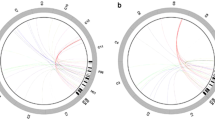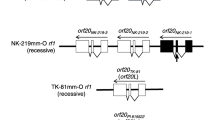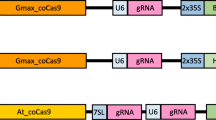The two main components of the R locus, designated P and S condition the production of a red pigment, chemically identifiable with cyanidin 3-glucoside, in the plant and seed tissues respectively. In this paper we present some data on the structural organization in terms of its P and S components of an unstable form of R, designated R st, and of two of its derivatives. The superscript st (stippled) refers to a distinctive pattern of aleurone variegation conditioned by R st. The instability is seemingly the result of the interaction of the S component of R st with an adjacent element affecting its gene action.
The two stippled derivatives analyzed are R sk (smoky) that conditions a different pattern of aleurone variegation and R sc (self-colored) characterized by a homogeneous aleurone pigmentation. Assuming that R st is a gene complex, p S st in structure, heterozygous P s / p S st individuals should yield P S st and p s recombinants, besides the parental P s and p S st strands.
Accordingly Ps / p S st male parents, carrying appropriate outside markers, were crossed with a p s / p s line. Among the progeny of this cross the exceptional individuals carrying nonparental strands were isolated as presumed intralocus recombinants and their flanking markers constitution was established. This analysis, extended to the p S sk and p S sc complex shows:
-
(1)
a disparity in the production of the two nonparental strands, with an excess of p s over P S st
-
(2)
the occurrence of a distinctive morphology in about one half of the exceptional individuals carrying a p s strand
-
(3)
negative interference in conjunction with intralocus events, on the hypothesis that the latter are the result of reciprocal exchange between genes or the R complex.
The possible origin of the nonparental strands through a mechanism of gene conversion or chromosomal deletion is considered and the evidence in favour or against either hypothesis is discussed.
The occurrence of P S st strands offers the opportunity to analyze the effect of S st on P gene action.
This test was performed by comparing the pigment concentration and distribution of individuals genotypically P S st/p s and p S st / P s. The comparison shows that seedlings of the two genotypes differ significantly both in the amount of pigment produced and its distribution. While the former determines a weak pigmentation, phenotypically recognisable as sectors or fine stripes along the primary root, the latter shows a homogencous pigmentation amounting to six times that found in P S st seedlings.
These observations seem to indicate that both P and S, when lying in coupling on the same chromosome together with the instability factor, are coordingted in their action by the latter.
Similar content being viewed by others
References
Ashman, R. B. (1970). The compound structure of the R st allele in maise. Genetics 64: 239–245.
Brink, R. A. (1964). Genetic repression of R action in maize. Symp. Soc. Study Develop. Growth 23: 182–230.
Brink, R. A., E. D. Styles & J. D. Axtell (1968). Paramutation: directed genetic change. Science 159: 161–170.
Chovnick, A. (1966). Genetic organization in higher organisms. Proc. Roy. Soc. Lond. (B) 164: 198–208.
Chovnick, A., V. Finnerty, A. Schalet & P. Duck (1969). Studies on genetic organization in higher organisms: I Analysis of a complex gene in Drosophila melanogasier. Genetics 62: 145–160.
Cornu, A. & P. Dommergues (1971). Induction de conversion au niveau de deux gènes liés intervenant dans la synthèse des anthocyanes chez Petunia hybrida hort. C. R. Acad. Sc. Paris 272: 3291–3294.
Dooner, H. K. & J. L. Kermicle (1971). Structure of the R r tandem duplication in maize. Genetics 67: 427–436.
Emerson, R. A., G. W. Beadle & A. C. Fraser (1935). A summary of linkage studies in maize. Mem. Cornell Univ. Agric. Exp. St. 180.
Emmerling, M. H. (1958). An analysis of intragenic and extragenic mutations of the plant color component of the R r gene complex in Zea Mays. Cold Spr. Harb. Symp. Quant. Biol. 23: 393–407.
Fogel, S., D. H. Hurst & R. K. Mortimer (1971). Gene conversion in unselected tetrads from multipoint crosses. Stadler Symp. 1–2: 89–110.
Gavazzi, G. (1967). Control of gene action in the synthesis of anthocyanin in maize. Molec. Gen. Genet. 99: 151–164.
Gavazzi, G. & G. Avila (1969). Analysis of the structural organization of R st and R sk in Zea Mays. Molec. Gen. Genet. 104: 235–240.
Gavazzi, G. & G. Avila (1969). Recombination in the long arm of abnormal chromosomo 10. Maize Genet, News Lett. 43: 101–104.
Ghidoni, A. (1971) Non-random transmission of chromosomes in trisomic plants. Maize Genet. News Lett. 45: 115–119.
Green, M. M. (1968) Some genetic properties of intrachromosomal recombination. Molec. Gen. Genet. 103: 209–217.
Kermicle, J. L. (1970). Somatic and meiotie instability of R-stippled, an aleurone spotting factor in maize. Genetics 64: 247–258.
Laughnan, J. R. (1961). The nature of mutation in terms of gene and chromosome changes. In: Symposium on Mutation and Plant Breeding. Natn. Acad. Sci. Nat. Res. Coun. Publ. 891: 3–29.
Lewis, E. B. (1967). Genes and gene complexes. In: R. A. Brink (Ed.) Heritage from Mendel. Ed. Univ. Wisconsin Press.
Nelson, O. E. (1968). The waxy locus in maize. II. The location of the controlling elements. Genetics 60: 507–524.
Nga, B. H. & J. A. Roper (1968). Quantitative intrachromosomal changes arising at mitosis in Aspergillus nidulans. Genetics 58: 193–209.
Rhoades, M. M. (1942). Preferential segregation in maize. Genetics 27: 395–407.
Salamini, F. & C. Lorenzoni (1970). Genetical analysis of Glossy mutants of maize III. Intracistron recombination and high negative interference at the gl locus. Molec. Gen. Genet. 108: 225–232.
Stadler, L. J. (1951). Spontaneous mutation in maize. Cold Spr. Harb. Symp. Quant. Biol. 16: 13–47.
Stadler, L. J. & M. G. Neuffer (1953). Problems of gene structure II. Separation of R r elements (S) and (P) by unequal crossing over. Science 117: 471–472.
Stadler, L. J. & M. H. Emmerling (1955). Relation of unequal crossing-over to the interdependence of R r elements (P) and (S). Genetics 41: 124–137.
Stevens, W. L. (1942). Accuracy of mutation rates. J. Genet. 43: 301–307.
Author information
Authors and Affiliations
Additional information
Research partially financed by the C.N.R. (Consiglio Nasionale delle Ricerche, Rome).
Rights and permissions
About this article
Cite this article
Gavazzi, G., Calati, D. Study of intralocus events leading to R stippled (R st) recombinants in Zea mays . Genetica 43, 489–503 (1972). https://doi.org/10.1007/BF00115594
Received:
Accepted:
Issue Date:
DOI: https://doi.org/10.1007/BF00115594




